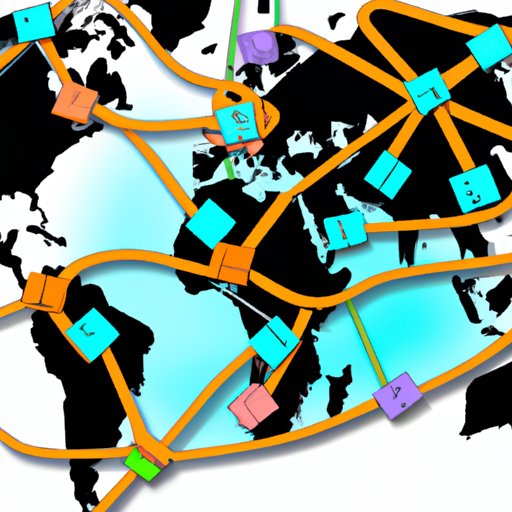Introduction
Global supply chain management (GSCM) is an important part of doing business in today’s global marketplace. It involves managing the flow of goods and services from suppliers, manufacturers, and retailers all over the world. GSCM is a complex process that requires careful planning and execution to ensure that products are delivered on time, at the right cost, and with the highest possible quality.
In this article, we will explore what a global supply chain is, the components involved, and the challenges and benefits of implementing one. We will also look at case studies of successful global supply chains and discuss how to create an efficient global supply chain. Finally, we will examine the impact of technology on global supply chains and their overall benefits.
An Overview of Global Supply Chain Management
A global supply chain is a complex network of resources and processes that are used to deliver goods and services to customers all over the world. It includes everything from the procurement of raw materials to the delivery of finished products. The goal of a global supply chain is to optimize the entire supply chain process and ensure that customers receive their orders in a timely manner.
What is a Global Supply Chain?
A global supply chain is a system of interconnected logistics activities and processes that span across multiple countries and regions. It can involve a variety of stakeholders such as suppliers, manufacturers, distributors, retailers, and customers. Each of these stakeholders has a role to play in the global supply chain, and they must work together to ensure that the supply chain runs smoothly.
Components of a Global Supply Chain
The components of a global supply chain include: sourcing, manufacturing, warehousing, transportation, distribution, and customer service. Each component plays an important role in ensuring that the supply chain operates efficiently and effectively. For example, sourcing involves finding the right suppliers for the necessary raw materials, while manufacturing involves transforming those materials into a finished product. Warehousing is used to store products until they are needed, and transportation is used to move them from place to place. Distribution and customer service ensure that the products are delivered to the customer in a timely manner.
The Role of Technology in Global Supply Chains
Technology plays an important role in global supply chains. It enables companies to track inventory levels, monitor shipments, and make data-driven decisions. Technology can also be used to automate processes such as order fulfillment, invoicing, and payments. By leveraging technology, companies can gain greater visibility into their supply chain operations and make informed decisions that will help to improve efficiency and reduce costs.

Case Studies of Successful Global Supply Chains
There are many companies that have successfully implemented global supply chains. These companies use a variety of strategies to ensure that their supply chains operate efficiently and effectively. Here are a few examples of companies with successful global supply chains:
- Amazon: Amazon is one of the most successful companies when it comes to global supply chains. They use a combination of advanced technology, strategic partnerships, and data-driven decision making to ensure that their supply chain runs smoothly.
- Walmart: Walmart has been able to leverage its massive scale to create an efficient global supply chain. Through the use of advanced logistics technologies and data analysis, Walmart has been able to reduce costs and improve the speed of deliveries.
- Apple: Apple has created a highly efficient global supply chain by utilizing innovative technologies such as RFID tags and cloud computing. This allows them to track every step of the supply chain process and make sure that products are delivered to customers quickly and efficiently.
These companies have been able to achieve success by utilizing a combination of technology, strategic partnerships, and data-driven decision making. By leveraging these tools, they have been able to create efficient global supply chains that enable them to deliver products to customers quickly and at a lower cost.
How to Create an Efficient Global Supply Chain
Creating an efficient global supply chain is no easy task. Companies must consider a variety of factors when designing their supply chains, such as cost, risk, complexity, and cultural and regulatory differences. Here are some steps for building a global supply chain:
- Identify and evaluate potential suppliers.
- Develop a strategy for managing costs and risks.
- Select the most suitable transportation and logistics providers.
- Ensure compliance with local laws and regulations.
- Implement technology solutions to increase visibility and tracking.
- Monitor performance and make adjustments as needed.
It is important to remember that each company’s global supply chain will be different depending on their needs and goals. Companies should take the time to consider all of the factors involved before designing their global supply chain.

Challenges Faced by Global Supply Chains
Global supply chains can face a variety of challenges, including cost and risk management, complexity of global logistics, and cultural and regulatory differences. Companies must be prepared to manage these challenges if they want to create an efficient global supply chain.
Cost and Risk Management
Cost and risk management are essential parts of global supply chain management. Companies must carefully analyze their supply chain process and identify potential risks. They must also develop strategies for managing costs and minimizing risks. This can include using insurance, hedging, and other risk mitigation techniques.
Complexity of Global Logistics
Global logistics can be complex due to the number of stakeholders involved and the various regulations and laws that must be followed. Companies must understand the complexities of global logistics and be prepared to manage them if they want their supply chains to run smoothly.
Cultural and Regulatory Differences
Cultural and regulatory differences can present a challenge for global supply chains. Companies must be aware of the cultural and regulatory requirements of each country in which they operate and make sure that their supply chain processes comply with those requirements.

The Impact of Technology on Global Supply Chains
Technology has had a major impact on global supply chains. It has enabled companies to automate processes, improve visibility and tracking, and make data-driven decisions. Here are some of the ways in which technology has impacted global supply chains:
Automation of Processes
Technology has enabled companies to automate their supply chain processes. This can include automating order fulfillment, invoice processing, and payments. Automation can reduce errors, increase efficiency, and improve accuracy.
Improved Visibility and Tracking
Technology has enabled companies to gain greater visibility into their supply chains. This can include real-time tracking of shipments, inventory levels, and customer orders. This increased visibility can help companies make more informed decisions and ensure that their supply chains are running efficiently.
Data-Driven Decision Making
Data-driven decision making has become increasingly important in global supply chains. Companies are now able to collect and analyze data from every step of the supply chain process. This data can then be used to make more informed decisions and optimize the supply chain.
Benefits of Utilizing a Global Supply Chain
Utilizing a global supply chain can bring a variety of benefits to companies. Here are some of the benefits of utilizing a global supply chain:
Access to Lower Costs
Companies that utilize global supply chains can access lower costs due to economies of scale and reduced transportation costs. This can result in improved profitability and increased competitiveness.
Increased Efficiency
Global supply chains can increase efficiency by reducing lead times and eliminating unnecessary steps. This can result in faster delivery times and better customer satisfaction.
Improved Product Quality
Utilizing a global supply chain can improve product quality by increasing visibility and reducing errors. This can result in higher customer satisfaction and improved brand loyalty.
Conclusion
Global supply chain management is a complex process that requires careful planning and execution. Companies must consider a variety of factors when designing their supply chains, such as cost, risk, complexity, and cultural and regulatory differences. Technology has had a major impact on global supply chains, enabling companies to automate processes, improve visibility and tracking, and make data-driven decisions.
Utilizing a global supply chain can bring a variety of benefits to companies, including access to lower costs, increased efficiency, and improved product quality. Companies must be prepared to manage the challenges associated with global supply chains if they want to create an efficient and successful supply chain.
Overall, global supply chains can have a major impact on a company’s success. By leveraging technology, strategic partnerships, and data-driven decision making, companies can create efficient and effective global supply chains that enable them to deliver products to customers quickly and at a lower cost.
(Note: Is this article not meeting your expectations? Do you have knowledge or insights to share? Unlock new opportunities and expand your reach by joining our authors team. Click Registration to join us and share your expertise with our readers.)
